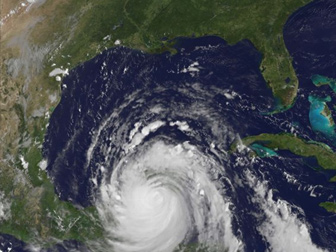Dean was 3rd most intense Atlantic hurricane at landfall
Dean was 3rd most intense Atlantic hurricane at landfall
mongabay.com
August 21, 2007
Hurricane Dean was the third most intense Atlantic hurricane to make landfall, according to forecasters at the National Hurricane Center who measured the storm’s central atmospheric pressure.
Jamie Rhome, a hurricane specialist with the National Hurricane Center, said that a Global Positioning System device dropped from a hurricane hunter aircraft found Dean had a central pressure of 906 millibars just before landfall. Scientists use pressure readings to determine the strength of a storm. The lower the pressure — hence the greater the differential between the eye and the swirling winds of the storm — the stronger the hurricane.
Dean was rated a Category 5 storm at landfall Tuesday in Mexico’s Yucatan Peninsula with sustained winds of 165 mph (265 kph) and gusts reaching 200 mph (322 kph).
A Category 5 hurricane is the strongest and most severe class of hurricane on the scale for measuring the strength of hurricanes. The scale, known as the Saffir-Simpson Hurricane Scale, classifies hurricanes by the intensity of their sustained winds, storm surge and flooding, developed in 1969 by civil engineer Herbert Saffir and National Hurricane Center director Bob Simpson. A Category 5 hurricane will have sustained winds of greater than 156 mph (250 km/h or 136 kt) and is capable of causing complete roof failure on residences and buildings. Evacuation of residential areas may be required in areas lying in the expected path of a Category 5 hurricane.
 This image of Hurricane Dean was created with data from Geostationary Operational Environmental Satellite (GOES-12), which is operated by the National Oceanic and Atmospheric Administration. The image was created on August 21 at 9:10 a.m. EDT (13:10 UTC) by NASA’s GOES Project, located at NASA’s Goddard Space Flight Center, Greenbelt, Md. |
Category 5 hurricanes may cause a storm surge greater than 19 feet (5.5 m). Such a storm surge can cause extensive flooding and major damage to low elevation structures. In Hurricane Katrina, the storm surge caused widespread damage along the Gulf Coast including Mississippi and Louisiana. In New Orleans, the storm surge caused the failure of levees that normally protect the city from flooding. As a result, 80% of New Orleans was swamped.
Three Category 5 Hurricanes have made landfall in the United States since 1900. Among these are Hurricane Andrew (Southern Florida and south-central Louisiana from August 16 to August 28, 1992; 23 deaths in the United States; $26.5 billion in damage in the United States), Hurricane Camille (Mississippi and Louisiana in August 1969; 143 killed along Alabama, Mississippi, and Louisiana + 113 people in Nelson County, Virginia; $6.1 billion 1996 dollars in damage; storm surge of 24 feet (7.3 meters)), and the Labor Day Hurricane of 1935 (Florida Keys in September 1935; 423 deaths). Hurricane Gilbert was a Category 5 hurricane that caused significant destruction in the Caribbean and the Gulf of Mexico when it struck in September 1988. 318 were killed.
The National Hurricane Center said the only other storms that hit land with a lower pressure were the 1935 hurricane that hit the Florida Keys and Hurricane Gilbert.
Hurricane Wilma (October 2005) was the most intense Atlantic hurricane ever recorded with a pressure reading of 882 millibars when it was in the Caribbean. The lowest pressure ever recorded in a hurricane was 870 millibars in Typhoon Tip (tropical cyclones forming in the northwestern Pacific Ocean are called typhoons) in 1979.
Related
Global warming is causing stronger Atlantic hurricanes finds new study — 3/01/2007
Global warming is fueling stronger hurricanes according to a new Geophysical Research Letters study that revises that database of historic hurricanes. Previously the hurricane database was considered inconsistent for measuring the record of tropical storms since there have been significant improvements in the technology to measure storms since recording-keeping began. Before the development of weather satellites, scientists relied on ship reports and sailor logs to record storms. The advent of weather satellites in the 1960s improved monitoring, but records from newer technology have never been squared with older data. The new study “normalizes” the hurricane record since 1983.
Hurricane intensity linked to global warming — 8/15/2006
A new study says climate change is affecting the intensity of Atlantic hurricanes and that hurricane damage will likely worsen in coming years due to increasing ocean temperatures. Unlike recent studies that have linked higher sea temperatures to an increase in the number of hurricanes, the new research shows a direct relationship between climate change and hurricane intensity.
Number of Category 4 and 5 hurricanes has nearly doubled over past 35 years — 9/16/2005
The number of Category 4 and 5 hurricanes worldwide has nearly doubled over the past 35 years, even though the total number of hurricanes has dropped since the 1990s, according to a study by researchers at the Georgia Institute of Technology and the National Center for Atmospheric Research (NCAR). The shift occurred as global sea surface temperatures have increased over the same period. The research appears in the September 16 issue of Science.
This article used information from the AP, NOAA, and NASA.